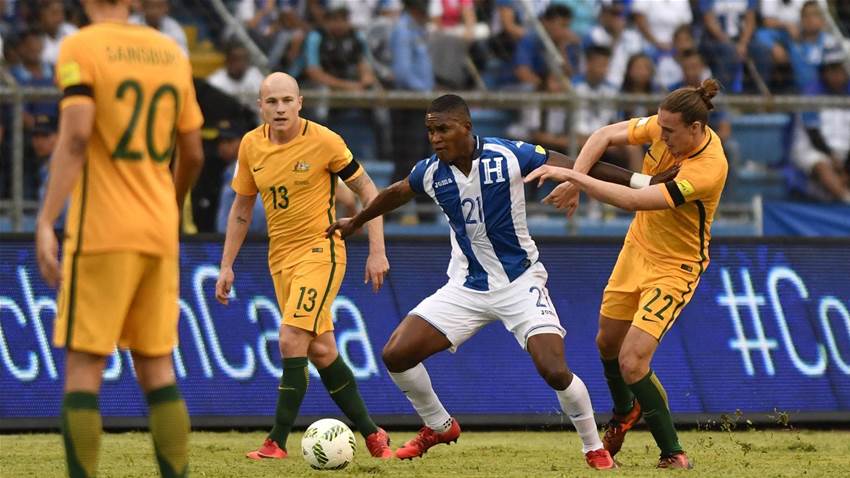A change in Ange Postecoglou’s system saw the Socceroos dominate a pacey Honduras side, coming away from the tricky away leg with a clean sheet, but no goals.
The diamond midfield
Whether the back three would be maintained or not was never really a question, but Ange Postecoglou has lately shown the tendency to adjust what happens in midfield from a game-to-game basis.
Even across the two legs of the Syria matches, there were identifiable changes in the approach, with the structure of the box midfield changing as well as the methods of final third penetration.

Jedinak, Luongo, Mooy and Irvine come together to form a midfield diamond.
Starting the match were the returning Mile Jedinak, Aaron Mooy, Massimo Luongo and Jackson Irvine (who would later be replaced by Tommy Rogic). The four players involved all appeared to have differing roles within the system, all of which we be explored below.
Mile Jedinak (holding midfielder)
The skipper was enormous in his first game back after a long injury layoff, and he anchored the midfield expertly throughout the match. He was a stable presence in central areas, rarely deviating and with a much lower range of movement than his midfield compatriots.
He performed key roles both with and without the ball, and was a key part in the build-up of many Australian attacks.
Defensively, Jedinak’s main function was to screen the back three and restrict Honduras’ access to their sole striker. In this regard he performed his duties well, as the times when Honduras were able to play through Anthony Lozano were few and far between.
He also won many of his aerial duels and won numerous second balls, minimising the effectiveness of Honduras’ transition football.
His positioning whilst his team was in possession was also integral to the Socceroo’s rest defence, ensuring that he was always in a position to prevent the effectiveness of an opposition counter attack.
As well as the defensive solidarity that he provided, Jedinak was also a key figure in the construction of Australia’s possession, consistently positioning himself behind the first line of pressure.

Jedinak’s movement between and behind the first line of pressure.
In doing so, Jedinak was able to offer a passing option that cut defenders out of the game and allowed him to receive the ball in space. From this position, he could either directly progress the play himself, or switch the point of attack to a different part of the pitch.
There were also occasions when Jedinak would move into the back three to take up the role of a centre-back, allowing for one of them to progress with the ball and create superiorities in midfield.
Overall, the skipper played an important role in both sides of Australia’s game, ensuring defensive stability throughout.
Aaron Mooy (left-sided central midfielder)
The Huddersfield star enjoyed a fairly extended range of movement, and was provided with the most freedom of all the midfielders. This allowed him to perform a number of key functions, both offensively and defensively. Without possession, Mooy would generally either press the ball carrier if in close proximity or cut the line of one of the midfielders to prevent Honduras from playing a short option.
In combination with Luongo, this restricted the options of the possibilities of the Hondurans and often forced a long ball. With the ball, there were two distinct responsibilities for Mooy; the first was his engagement with left-back-cum-winger Aziz Behich, and the second was his vertical movement into the space either side of Jackson Irvine.
Mooy’s interactions with Behich were crucial to the effective penetration of the Socceroos. As shown below, they would work together as often as possible to overload the opposition full-back, either allowing space for Mooy on the outside of the box or for Behich to get in behind the Honduran back four.

Mooy and Behich’s combination on the left-hand side.
The two had a very good dynamic throughout the game, with Mooy in particular reacting quickly to whenever Behich vacated space for him to move into. For example, if Behich engaged in the vertical movement that was experienced in the second leg against Syria, Mooy would move laterally to fill the space that was left behind.

When this movement (above against Syria) occurred from the left wing, Mooy would move into the vacated space.
As mentioned earlier, Mooy also had another aspect to his role. With Jackson Irvine as the sole attacking midfielder, there was more space available on that line than there is when Australia’s usual box midfield is employed.
Due to this, Mooy and Luongo were able to attack these spaces from deep, creating another method to get in behind the Honduran defenders – but more on this later.
Massimo Luongo (right-sided central midfielder)
Like Mooy, QPR skipper Massimo Luongo enjoyed a fairly generous range of movement, although not quite to the same degree as his teammate. When Honduras were on the ball, Luongo played a slightly different role to Mooy.
In order to combat the transition football from Honduras, Luongo would position himself in central areas where he would be in an optimum position to win the second ball. In some respects however, he complemented Mooy’s responsibilities.
For example, during the rare constructed build-up moments of Honduras, Luongo would man-mark his closest midfielder in an effort to limit options ahead of the ball. However, Luongo’s talents were best used when Australia had the ball – he found himself consistently involved in many phases of possession, from acting as a wall to return a pass or driving forward, progressing the play alone.

Luongo’s positioning behind two Honduran lines of pressure posed a serious threat.
During build-up, Luongo offered a different option to Jedinak in a position which was higher risk but higher reward.
When Jedinak was behind the first line of pressure, Luongo moved himself into a passing line which intersected two – if the passes into him were successful and he received the ball facing forward, Luongo could directly start an attack against only a few Honduran defenders.
Unfortunately, this did not happen regularly, but a pass of such difficulty cannot be expected to happen frequently. He was also tasked with occupying the central area of the pitch ahead of Jedinak as often as possible, ensuring at least one option between the two to switch the play from a higher position, as well as offering further protection against potential counter-attacks.
Like Mooy, Luongo was also able to exploit the spaces either side of Irvine, which is explained in further detail on the next page.
Jackson Irvine (attacking midfielder)
Irvine performed something of a stability role from his advanced position, which was able to give rise to both the attacking and the defensive aspects of Australia’s general play. Firstly, the fact that there is a single attacking midfielder in itself provides a point of difference compared to previous systems, with more space being left vacant on that line of play.
Both Mooy and Luongo consistently applied themselves in this regard, looking to exploit the space either side of Irvine when the ball was in suitable positions, as seen below. Instead of engaging the back four directly and trying to get in behind himself, Irvine usually maintained his position and allowed others to perform this function instead, preserving his goal-scoring threat in the middle of the pitch.

Luongo attacking the space next to Jackson Irvine, triggered by deeper location of the ball.
Irvine’s positioning facilitated the above movement, which eventually resulted in a few chances for Australia throughout the match. Irvine himself also offered another outlet during build-up, appearing in a passing line in the vacant spaces when one of the centre-backs or Jedinak were on the ball.
This movement placed him between and behind three lines of pressure – on the few occasions when this pass was able to be made, Irvine posed an immediate threat and endangered the structural integrity of the Honduran defensive block.
When Australia were without possession, Irvine was also responsible for pressing the player on the ball in an attempt to prevent the long ball, as illustrated in the diagram below.

The pressing system of Australia: Luongo and Mooy marking, Irvine towards the ball with Jedinak screening.
His pressing occurred immediately after loss of possession, and ensured that Mooy and Luongo quickly transitioned towards their nearest opponent to restrict the options going forward. Juric would apply backwards pressure, and if Irvine was not able to reach the ball in time, Honduras would attempt to play a long pass. Overall, Jackson Irvine acted as somewhat of the glue that helped to combine the dynamics of the Australian midfield diamond, a tactic which certainly appeared to have worked for Ange Postecoglou’s men.
Conclusion
A switch to a diamond midfield saw a clean sheet with Honduras’ chances being significantly limited, but a number of missed opportunities at the other end saw in a 0-0 result. Australia will be hoping for a win in Sydney in the return leg – if they do that, they’ll be on their way to the World Cup.
Nathan Muir is an Australian tactical analyst and coach. You can contact him on Facebook @NathanMuirFootball or on Twitter @NathanKMuir.
Related Articles

Champion A-League coach set to join Premier League giants

Under the gun: Spurs fans want Ange to be a loser in night of spite













